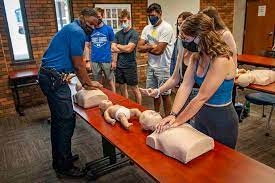Mastering Life-Saving Skills: The Value of CPR Classes

The Importance of CPR Classes
Cardiopulmonary resuscitation (CPR) is a life-saving technique that can be crucial in emergencies such as cardiac arrest or drowning. CPR classes are designed to teach individuals how to perform CPR effectively and confidently.
One of the key benefits of taking CPR classes is that it equips you with the knowledge and skills to act quickly in an emergency situation. By learning how to perform chest compressions and rescue breaths, you can help sustain blood flow and oxygenation to vital organs until professional help arrives.
Moreover, CPR classes also cover topics such as using automated external defibrillators (AEDs) and how to respond to choking incidents. These additional skills can further enhance your ability to provide immediate assistance when needed.
Another important aspect of CPR classes is that they increase public awareness about the importance of bystander intervention. By training more individuals in CPR, we can create a community of first responders who are ready to step in and help save lives when every second counts.
In conclusion, taking CPR classes is not only beneficial for your own knowledge and confidence but also for the well-being of those around you. Being prepared to perform CPR can make a significant difference in emergency situations and potentially save lives.
Top 5 Essential Tips for Effective CPR: Enhance Your Life-Saving Skills
- Ensure proper hand placement when performing chest compressions.
- Remember to tilt the casualty’s head and lift their chin to open the airway.
- Maintain a steady rhythm while giving chest compressions.
- Don’t forget to give rescue breaths in between chest compressions.
- Attend regular CPR classes to stay updated on techniques and guidelines.
Ensure proper hand placement when performing chest compressions.
When attending CPR classes, it is crucial to ensure proper hand placement when performing chest compressions. Placing your hands correctly on the chest of the individual in need can make a significant difference in the effectiveness of the compressions. By following the guidelines taught in CPR classes and positioning your hands correctly over the lower half of the breastbone, you can maximize blood circulation and increase the chances of a successful resuscitation. Proper hand placement is a fundamental aspect of performing CPR correctly and can greatly impact the outcome in an emergency situation.
Remember to tilt the casualty’s head and lift their chin to open the airway.
In CPR classes, one crucial tip to remember is to tilt the casualty’s head and lift their chin to open the airway. This simple yet essential manoeuvre helps ensure that air can flow freely into the lungs, allowing for effective respiration during emergency situations. By following this step, you can help maintain a clear airway and maximise the chances of successful resuscitation. It is a fundamental skill that can make a significant difference in saving lives when performing CPR.
Maintain a steady rhythm while giving chest compressions.
When attending CPR classes, it is crucial to remember the importance of maintaining a steady rhythm while giving chest compressions. Consistency in the rate and depth of compressions is key to effectively circulating blood and oxygen throughout the body of the individual in need. By following a steady rhythm, you can maximise the chances of a successful outcome and provide vital support until professional medical assistance arrives. Mastering this technique through practice and training in CPR classes can greatly enhance your ability to respond confidently and effectively in emergency situations.
Don’t forget to give rescue breaths in between chest compressions.
In CPR classes, it is essential to remember the importance of giving rescue breaths in between chest compressions. While chest compressions help circulate blood throughout the body, rescue breaths provide vital oxygen to the lungs and brain. This combination of actions is crucial for maintaining oxygenation and increasing the chances of survival for someone in cardiac arrest. By ensuring that both chest compressions and rescue breaths are performed effectively and in the correct sequence, individuals can maximise their ability to provide life-saving assistance in emergency situations.
Attend regular CPR classes to stay updated on techniques and guidelines.
Attending regular CPR classes is essential to staying updated on the latest techniques and guidelines for life-saving interventions. By participating in ongoing training sessions, individuals can refresh their skills, learn about any new developments in CPR protocols, and ensure that they are well-prepared to respond effectively in emergency situations. Keeping up-to-date with CPR practices through regular classes not only enhances one’s proficiency but also instills confidence in their ability to provide timely and accurate assistance when it matters most.
